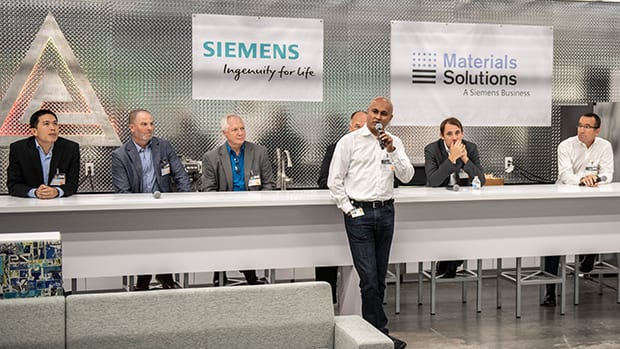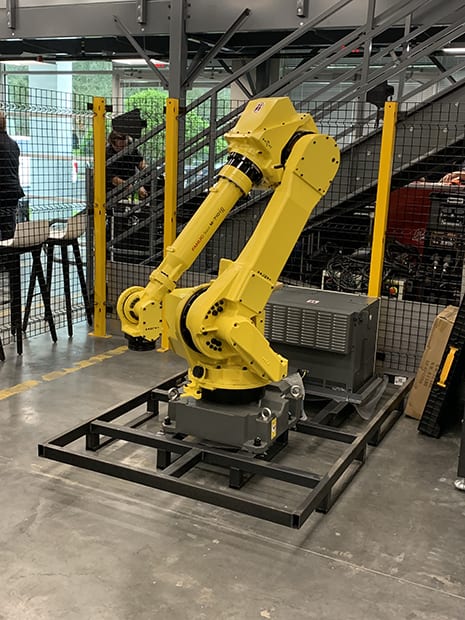Siemens Opens New Innovation Center in Orlando
The post Siemens Opens New Innovation Center in Orlando appeared first on POWER Magazine.
Siemens celebrated the official opening of an innovation center in Orlando, Florida. The only one of its kind in the U.S., it pairs design with manufacturing, robotics, rapid prototyping, scanning, and digital tools.
Designed to support the customers of Siemens Gas and Power, it is equipped with the latest digital technologies to make repairs faster and encourage the creation of new components, digital solutions, and additive manufacturing (AM).
"Innovation is key to address the many challenges facing our industry," said Vinod Philip, CEO of Siemens Service Power Generation (Figure 1).
 |
| 1. Vinod Philip speaks during the grand opening of the Siemens Innovation Center. Source: Archie Robb |
Philip said the innovation center is important due to three drivers:
- With the world changing so dramatically, it becomes more important to develop rapidly. Traditional ways of coming up with new solutions are much too slow.
- Performance is becoming more vital than ever and companies must strive to find ways to improve performance.
- Cost reduction and competitiveness provides plenty of options for customers.
The Siemens philosophy is that innovation is at its best when there is urgency to solve a pressing problem that is being solved by a diverse mix of people. Thus, the center brings together mechanical and electrical engineers with experts in manufacturing, service, software, finance, robotics, augmented reality, 3D printing, virtual reality, non-destructive evaluation (NDE), modeling, simulation, and strategy.
"We want to work closely with customers and partners to co-create new solutions," said Philip.
In the past, companies tended to develop in isolation and only look within their own field for knowledge and inspiration. Siemens has decided to broaden its perspective on technology. In collaboration with Materials Solutions, a Siemens business, the center provides on-site metal AM. Materials Solutions brings more than 12 years of AM experience to the table. The company will operate as a separate entity, distinct from Siemens.
This was done to save time in trying to figure out 3D printing within Siemens. Incorporating Materials Solutions provided the company with immediate know-how to apply AM to gas turbines and steam turbines. Additionally, the goal is to look beyond printing of parts to jointly develop new materials and new 3D printers. These services will be offered to the aerospace and energy sectors.
Materials Solutions built its reputation from its base in the UK. The center provides it with a U.S. presence. The UK office is primarily a production facility with 22 3D printing machines. It also develops new 3D printing processes. The Orlando site currently has two machines and a third is coming soon (Figure 2). The U.S. facility is there mainly for prototyping, development, and low-rate production.
 |
| 2. The Siemens Innovation Center in Orlando contains the latest in robotics technology. Source: Archie Robb |
In addition, Siemens has a 3D printing site in Finsping, Sweden, for component production as well as research and development, and a site in Berlin, Germany, which is used for new machine, material, process, and automation development. This makes up an innovation network that includes Siemens and Materials Solutions intellectual property.
"3D printing is not yet a push button technology," said Philip. "More development is needed in machines, processes, and materials."
Siemens plans to use this network to boost performance, heighten competitiveness, lower emissions, shorten lead and development times, and originate new business models. One example is inventory. Turbine blades and other components have a lengthy lead time. Traditionally, original equipment manufacturers (OEMs) carried a large stock in order to minimize delays in the provision of spare parts. 3D printing opens the door to on-demand provision of parts and rapid delivery.
Another business case involves aging turbines. There are some machines out there from the 1960s and 1970s that are still in operation. As they are no longer supported by their OEMs, or the OEMs are long gone, parts are unavailable. AM makes it possible to use 3D printing to continue to supply them with parts.
If the drawings are available, the parts can be made to order. Additionally, reverse engineering can be done using 3D scanning. The company has a 3D scanner that can scan any part that can be positioned on its platform. Digital images are then taken from all angles to provide a model that is accurate to very tight tolerances. Further, aging parts can be upgraded to enhance performance.
The Orlando center has yet another role. Siemens can use it to prove various applications it has under development. A component can be quickly manufactured in plastic and tested to see if it fits properly and functions as required. If so, it can be passed onto production for manufacturing. In some cases, these parts will be 3D printed, and in other cases, casting will be used.
Philip said that 3D printing makes sense for smaller quantities. If hundreds of parts are to be made, it is often more cost-effective to use traditional casting techniques.
"However, some modern parts can only be made using AM due to their geometric complexity, he said.
-Archie Robb is a writer based in Southern California specializing in business and technology..
The post Siemens Opens New Innovation Center in Orlando appeared first on POWER Magazine.